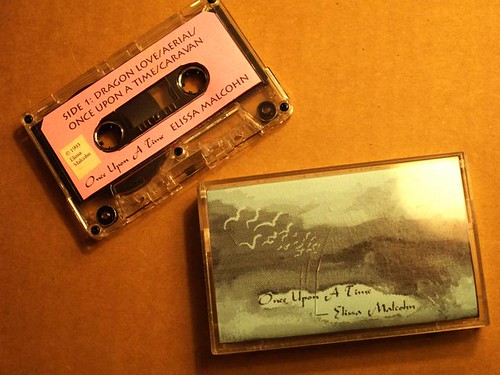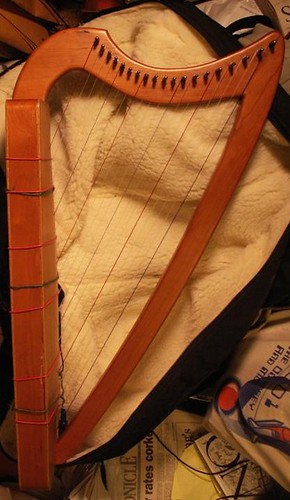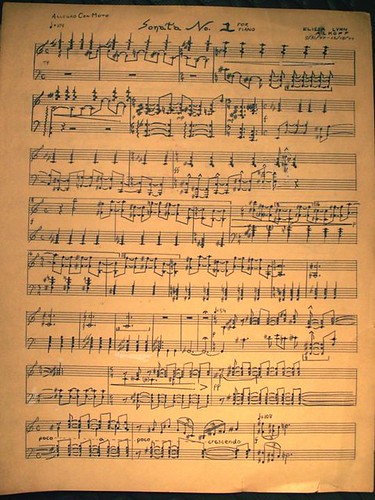Once Upon A Time

Journal entry, April 19, 1993: "It was now very clear to me that I was like a mute person being given vocal cords and, for the first time, able to take what was in my head and give it glorious voice."
Inspired by Brenda's comment, "And scat singing - oh, you gotta post a sound clip!" I hunted for some old cassette tapes....
When a major client switched from PCs to Macs in the early 90s I purchased a Macintosh Powerbook 160, an early notebook computer. It had a black-and-white screen and was nowhere near Internet-ready (this is years before I'd even heard of the Internet).
But it was a Mac. And that meant I could finally try my hand at MIDI.
MIDI (Musical Instrument Digital Interface) was a way for me to compose electronically. I'd been "doodling" on the piano since early childhood, playing songs by ear and improvising on my own. In college I had struggled past my abysmal sight-reading and written a couple of the doodles down in musical notation. My piano instructor (himself a composer) wisely told me not to grimace when I flubbed during a performance -- especially since I was playing my own sonata (see below), which nobody knew but me. I had, very reluctantly, left my piano behind when I moved from New York to Massachusetts in 1983.
A decade later, MIDI translator in hand, I purchased an entry-level program called EZ Vision, which did not use musical notation but a format patterned after the player piano roll. I learned that the sound sampler I wanted, one with traditional orchestral instruments, was less expensive than newer samplers with the latest synthetic sounds. Even so, my "traditional" sampler came with synthetic voices called "Grandfather," "Somber Winds," "Magic Bells," "Wrong Room" -- all of which I've used, plus others.

Mac Powerbook 160, showing the EZ Vision screen for the beginning of "Pilgrimage".
And I could have a piano again, in the form of a Yamaha YPP-50 electronic keyboard, that would fit in my attic apartment. When I had everything in place I hooked my MIDI box up to my keyboard on one end and my Mac on the other, plugged in the sound sampler and a boom box for recording onto cassette tape (before the days of CD-burning), and headphoned myself in. And I started laying down tracks.
Before 1993 was out I had put some of the doodles together into a collection called Once Upon A Time, named after the third selection. I found a place where I could buy unlabeled, blank cassette tapes. Making my own template, I designed and printed my own labels, using a paper cutter and X-Acto knife and gluing them to the tapes. In similar fashion I created liner notes, used a program called Sketcher to produce the cover, and used my dual-cassette recorder to make copies from the master tape. Seven Stars bookstore in Cambridge carried it. (No sales, but I once walked in to hear it playing from the store's speakers.) I gave copies away to friends and clients, just wanting to share.
Listening to the selections now, I can hear room for improvement. But I was inventing as I went along, learning the software and having a blast. These are all experiments and first drafts, as it were.
The selections on Once Upon A Time are all instrumental (other pieces that include my voice are also below) for reasons of technology -- or lack thereof. In the initial recording, my purely-MIDI pieces could travel through a wire directly into my tape recorder, through its microphone jack. Adding my voice would have introduced air that I didn't want to have in an "official" recording. My sound and production studio was my Cambridge living room.
The cats helped. Red's literal leaps of inspiration provided some of the flute in "Dragon Love" and the closing cymbal in "Caravan". Daisy's main contribution was in keeping Red otherwise occupied.
My new digital voice recorder serves as a kind of go-between -- alas, with some distortion (especially for the high bells, as in "First Snow"), because I've set it beside my tape player's speaker: the sounds travel through air rather than wire. But it's given me something to upload.
Dragon Love (5:22): I wanted to play around with a koto (a stringed instrument, whose name means "dragon"). At first I wondered what it would sound like with a guitar, but I ultimately decided against that combination for this piece. (I later combined koto and guitar in "Reflecting Pool.") Sampler voices used were Koto, Temple Bell, Gong/Cymbal, Flute, Cyberspace, Wind Chimes, Grandfather, Magic Bells, Tubular Bells, Somber Winds, and Cloud Chamber.
Aerial (4:36): The title comes from the street on which friends for whom I composed this live. One plays the cello, which features in the piece. The other had chosen the first two instruments I laid down, called Tinker Bell and Resting Pad. Other voices used were Piccolo, Chamber Horns, Timpani, Harp, Legato Strings, and Low Wind Instruments.
Once Upon A Time (8:58): A meander through various fairy tale moods. Sampler voices used were Whistl'n Joe, Harpstrings, Verb Horns, Cimbalon, Phaedra, Celesta, Classic Guitar, Resting Pad, Piccolo Peace, Flute, and Solo Violin.
Caravan (9:56): This has one of my favorite beginnings. Very dynamic. But then it gets a bit squishy before resolving at the end. Sampler voices used were Bell Ensemble, Timba Mallet, Deep Drum, Arco Strings, Timpani with Tone, Gong/Cymbal, Oboe, Harp, Verb Clarinet, Arco Basses, Clarinet/Flute, and Percussion I.
The Winding Path (6:54): My version of meditation music. Sampler voices used were Exotic Harp, Somber Winds, and Nice Night.
Oceans Away (4:43): My version of a sea shanty. (Original MIDI file has been lost, so no sampler voices listed.)
The Drowned Cathedral (3:58): My personal favorite of the Once Upon A Time selections, though perhaps a bit macabre. It was inspired by M.C. Escher's 1929 woodcut "The Drowned Cathedral" -- which for all I know was inspired by Claude Debussy's "The Engulfed Cathedral" (also called "The Sunken Cathedral"). Sampler voices used were Wrong Room, Vertigo Pad, Solo Violin, Analog Pad, Tubular Bells, and Piano.
First Snow (2:30): Composed in the heat of summer. (Original MIDI file has been lost, so no sampler voices listed.)
Pilgrimage (6:07): Another meander, this one with a sense of adventure. Sampler voices used were Legato Strings, Harpstrings, Violin & Celli, Electrovocal, Sombre Winds, Glitter God, Solo Chamber, and Piccolo Peace.
What Might Have Been (4:56): Somber, wistful brass. I was thinking of a mood on the order of "Taps" when I put it together. Sampler voices used were Bronze Pad, Trumpet I, Epilogue, Legato Strings, English Horn, Pizz Celli, and Arco Violas.
Tinkie's Toys (2:00): I composed this in honor of Tinker Bell, my friend Helen's white Persian cat. Having a sound sampler voice called Tinker Bell, I couldn't resist. To that I added Whistl'n Joe, Vienna Dream, and Reginatron.
Reflecting Pool (3:56): Here I've added my voice to the mix. And I found a way to combine Koto and Classic Guitar, after my unsuccessful attempt in "Dragon Love." Other sampler voices used were Reginatron and Flute/Oboe.
My scatting here is quite different from the beat I'd followed while singing with the jazz band in 1995. Their progressions were pretty predictable. One of my favorite jamming experiences was with a classical guitarist at a party. We musically led each other through a wondrous woods, filled with twists and turns neither of us could anticipate. We had each other flowing with wherever the music took us.
Save for the electronic keyboard, the selections that follow are about as low-tech as it gets. Again improvising as I went along, without MIDI software to help me edit, I recorded the first track on my dual-cassette tape recorder. Then I played that track back while recording the next -- letting the first track give me my cues. And so on. For a piece like "Fantasie for Four Hands, Duo Voice" (four tracks), that means a lot of air has come into the mix. Conversely, the "Solo Harp" is a single voice, with me playing a Flemish lap harp in front of a microphone.
Fantasie for Four Hands, Duo Voice (3:57): Two piano tracks, two voice tracks, each sequentially laid over the other. I had done the piano tracks first, then added my voice. In these improvisations I never know what I'm going to do next. No written music, nothing planned in advance.
Solo Harp (10:07): I had bought a 2-1/2-octave Flemish lap harp in the mid-1980s. For me it was like playing the piano except that I held my hands up rather than down. Without pedals or valves, I could not sharp or flat a note, limited to a diatonic rather than a chromatic scale.
The harp has traveled with me to various events at which I've provided background music, improvising for however long. I have played it on the street in Cambridge and Provincetown, at various parties, at a science fiction convention (at one point jamming with a woman who had brought her own harp). Most recently I played it at a tea to benefit the Florida State Poets Association.
It had extra strings attached for that event. Either from our move or from Florida humidity, I had found its sounding board pulled up and used wood glue, clamps, and string to at least temporarily put the harp back in tune.

Piano Sonata #1 (11:07): This recording dates from the year after I composed this piece in 1977 at age 18-19 (I began it on May 31 and finished it on December 18). I wrote musical notation for this one in the days long before my acquaintance with MIDI.
I had performed the sonata at my college, though this recording was made in the Brooklyn house where I grew up. (That man clapping and yelling "Bravissimo!" at the end was my father.) My slipping a bit of Dies Irae into the second movement was inspired by Sergei Rachmaninoff's use of it in his tone poem, Isle of the Dead.
Technically I can say I had played this at Tanglewood, though not on stage! My parents and I had visited there while I was still in college -- and at that time (though no longer), the grounds included a wonderful glass-walled room with a Steinway available for anyone to play who wanted to. In-between attending free rehearsals and picnicking on the lawn during performances, I spent as much time as I could in that room.

I haven't used the Mac (which contains some unrecorded compositions) since 1996 -- its viewscreen keeps fading out now. I still have my electronic keyboard, sound sampler, dual-cassette recorder, and likely my EZ Vision software on some 3-1/2 inch floppies somewhere.
Just in case my Muse returns to melody.











2 Comments:
Unfortunately these wouldn't load on my 3 year old iMac... I'll keep trying, sometimes persistence pays off. Looks like a rich musical heritage...
Like collages in audio. Your talents are boundless. I was able to listen to a few and enjoy them. Will check back later for more.
Post a Comment
<< Home